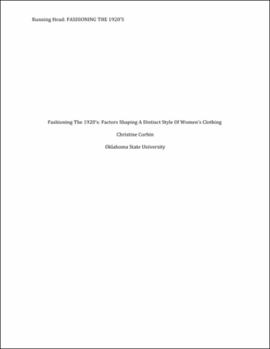| dc.contributor.author | Corbin, Christine | |
| dc.date.accessioned | 2017-10-10T20:56:53Z | |
| dc.date.available | 2017-10-10T20:56:53Z | |
| dc.date.issued | 2014-04-22 | |
| dc.identifier | oksd_corbin_HT_2014 | |
| dc.identifier.uri | https://hdl.handle.net/11244/52305 | |
| dc.description.abstract | The 1920's are often considered a decade of immense liberation for women. The iconic flapper is the image most associated with this decade, when the post-war economy was burgeoning and many new types of industry were taking off. The purpose of this thesis is to examine what advances women did make during this decade, how they fit into the changing fabric of society, and how these changes affected the clothes that they wore. By delving more deeply into these issues, it is possible to gain a more nuanced perspective about women's lives during the 1920's. The clothes that they wore reflect both the progress that was made, and the ways in which they were still held back from full independence. | |
| dc.description.abstract | This thesis was researched through a combination of historical texts and primary sources. There were many initial assumptions about the decade that served as a starting point for research. When analyzing this decade of women's clothing, three cultural, economic, and social forces appeared to be the most relevant in terms of the changes they brought to popular dress. These are identified as the rising acceptance of women's athleticism; the increase of women joining the work force; and media and the advertising industry's impact on body perception and consumerism. Women's athleticism had a positive impact on clothing by allowing for more utilitarian, comfortable garments to become accepted and even fashionable. Athletic clothing trickled down to the masses, greatly improving women's quality of life by allowing them comfort and greater ease of movement. As more women worked to join the work force, they began appropriating traditionally masculine styles in a sort of "wishful thinking" as they sought independence. Bobbed hair, the iconic Chanel suit, and all of the other masculine details that began to appear on women's garments are results of the increased effort to be financially independent. Finally, new media and advertising allowed new beauty ideals to spread very quickly. Since the economy was strong, women were not only exposed to new products and ideas about their appearance, they also had the means to buy new products. From the influences of advertising and the film industry, changes such as the acceptance of makeup, a huge increase in dieting, and new ideas about women's sexuality came about. | |
| dc.description.abstract | The 1920's were a complex decade. This thesis seeks to understand what caused the dramatic changes to women's clothing, and to temper the assumption that women only experienced advances during these years. By examining each of the three main factors that influenced change in women's clothing, it is possible to have a more nuanced understanding of women's place in society. | |
| dc.format | application/pdf | |
| dc.language | en_US | |
| dc.rights | Copyright is held by the author who has granted the Oklahoma State University Library the non-exclusive right to share this material in its institutional repository. Contact Digital Library Services at lib-dls@okstate.edu or 405-744-9161 for the permission policy on the use, reproduction or distribution of this material. | |
| dc.title | Fashioning the 1920's: Factors shaping a distinct style of women's clothing | |
| osu.filename | oksd_corbin_HT_2014.pdf | |
| osu.accesstype | Open Access | |
| dc.type.genre | Honors Thesis | |
| dc.type.material | Text | |
| dc.contributor.director | Petrova, Adriana G. | |
| dc.contributor.facultyreader | Armstrong, Cosette M. | |
| thesis.degree.discipline | Design, Housing and Merchandising | |
| thesis.degree.grantor | Oklahoma State University | |
